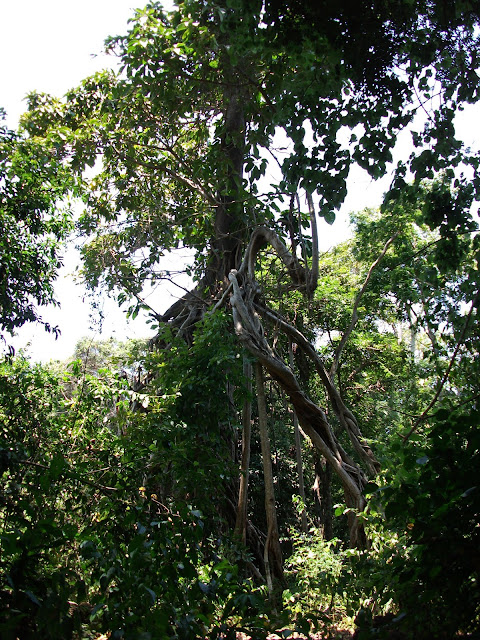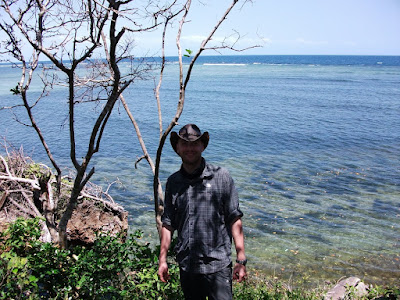Once caught the specimen was carefully removed from the net, being careful not to damage their fragile wings (their bodies are deceptively strong) and then logged and photographed both the top an underside of the wing in order to identify them back at base.
A log of my travels and experiences working in Kenya!
Thursday, 21 October 2010
Butterfly Sweep-Netting
Butterflies are an important part of the ecosystem and a great identifier species. Individual species tend to favor certain flora (both in in their larval and imago stages) and can be used to help to indirectly identify plants species and their density.The number of species of butterfly and their population density helps to provide us with an indication of the state of an environment.
We started in Shimoni Forest West along the shortcut to the Transects. We swept for a total of 1 hour, which was divided up between 3 people, each doing 20min simultaneously.
Once caught the specimen was carefully removed from the net, being careful not to damage their fragile wings (their bodies are deceptively strong) and then logged and photographed both the top an underside of the wing in order to identify them back at base.
Once caught the specimen was carefully removed from the net, being careful not to damage their fragile wings (their bodies are deceptively strong) and then logged and photographed both the top an underside of the wing in order to identify them back at base.
Tuesday, 19 October 2010
Building Pitfall Traps
This week we set up 4 pitfall traps and drift nets in Shimoni Forest West. A pitfall trap is sunk into the ground and is designed to trap small animals, such as insects, amphibians and reptiles.
This takes some amount of blood, sweat and tears, well not so much the blood an tears but lots of sweat, a few cuts and bruises and a lot of blisters. This is because Shimoni Forest sits on top of Coral Rag, which is a Limestone material composed of ancient coral reefs.
The drift nets (set up in a T section) direct small animals towards the pitfall traps. The traps are set in the evening and those that fall in are unable to escape and are collected first thing in the morning.
The Species are logged, recorded and then set free.
Friday, 8 October 2010
The Mangroves
As part of the expedition it is important to gather and improve upon local knowlege and information. As there is very little information on the mangroves of Shimoni Forest East, GVI has begun a new project, logging and identify the different plants and animal species
The Mangroves are an important costal habitat and ecosystem. They provide coastal areas with protection from erosion and storm surges and the mangrove's massive root system dissipates wave energy and slows tidal waters so that sediment is deposited.
The 2010 update of the World Mangrove Atlas indicated that a fifth of the world's mangrove ecosystems have been lost since 1980 and a number of species are under threat. The ecosystem provides a home for a variety of plants and animal species.
The Mangroves are an important costal habitat and ecosystem. They provide coastal areas with protection from erosion and storm surges and the mangrove's massive root system dissipates wave energy and slows tidal waters so that sediment is deposited.
The 2010 update of the World Mangrove Atlas indicated that a fifth of the world's mangrove ecosystems have been lost since 1980 and a number of species are under threat. The ecosystem provides a home for a variety of plants and animal species.
Wednesday, 6 October 2010
The Project
The Program
For the first 4 weeks i'll be working on the Forestry Conservation Project in Shimoni, 1 week of Community Development in Mkwiro on Wasini Island teaching English, 1 week at the satellite camp at Savo and 4 weeks on the Marine Conservation Project working on Wasini Island and the Mkisite Marine Reserve.
The Forest Research Project, Shimoni Forest
The purpose of the Forest Research Project is to identify plant and animal species, monitor their population, density and distribution over time. The forest is divided into East and West, there are 6 transects on the East side and 3 on the West side. The transects on the West side are still to be completed. The transects are a number of parallel paths cut through the forest along a an East to West trajectory.
Shimoni Forest East
On Tuesday 05/10/10 we set off to collect and compile data on Canopy Cover and Height in Shimoni Forest East along Transect 4.
 |
| Heading into the Shimoni Forest |
 |
| Luke and Ayabei |
 |
| Me making some notes |
 |
| A crazy tree |
 |
| Inside the crazy tree |
We also logged information on species we spotted along the way, such as Suni, Angolan Black and White Colobus Monkeys, Palm Nut Vultures and the Common Rock Thrush.
 |
| Ayabei on the lookout for African Fish Eagles |
 |
| Me by the Coast |
Shimoni Forest West
On Wednesday 06/10/10 we began cutting a new section along Transect 3 in Shimoni Forest West. We also noted an causal observation we made along the way which included;
Sykes Monkeys
Angolan Black and White Colobus Monkeys
Yellow Baboons
Palm Nut Vulutres
African Fish Eagles
Lizards
Go Away Bird
Fork Tail Drongo
Black Kite
Zanj Elephant Shrew
 |
| Tim and a Caterpillar |
 |
| Can't beleive they actually let me loose with a Machete |
 |
| Ayabei showing us how it's done |
 |
| Faye an Tim clearing a path |
 |
| Tim, Ayabei and me stop for some lunch |
 |
| A Sykes Monkey |
 |
| A Sykes Monkey |
 |
| Faye working up a sweat |
Mombasa & Shimoni
After the initial shock of arriving in Mombasa i've begun to relax and really enjoy myself! It's hot and the work load keeps us very busy.
After i met everyone at the Reef Hotel in Mombasa we bored the bus and made our way to Shimoni.
 |
| This is a view from my hotel room |
 |
| The Reef Hotel |
 |
| And this is the beach at the back of the hotel |
Shimoni
We headed South and after traveling for 3hrs we ran out of tarmac, from here on in it's dirt tracks all the way. About an hour later we arrived at Shimoni.
 |
| This is the Main Street in Shamoni |
Shimoni literally means the "place of the caves" this is where the slaves were kept before being shipped off to work on the plantations.
 |
| The Slave Caves |
These caves run deep underground and continue miles inland and have been turned into a bit of a tourist attraction, not that there're many tourists in Shimoni.
 |
| The Entrance to the Caves |
After a quick tour of the cave and the town we headed back to the house to settle in.
 |
| Heading home |
Subscribe to:
Comments (Atom)

































